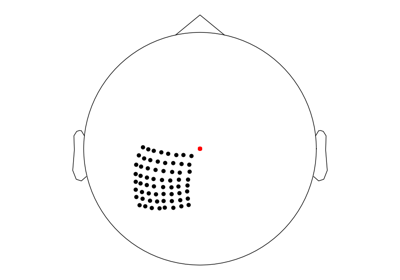mne_bids.BIDSPath¶
-
class
mne_bids.BIDSPath(subject=None, session=None, task=None, acquisition=None, run=None, processing=None, recording=None, space=None, split=None, root=None, suffix=None, extension=None, datatype=None, check=True)[source]¶ A BIDS path object.
BIDS filename prefixes have one or more pieces of metadata in them. They must follow a particular order, which is followed by this function. This will generate the prefix for a BIDS filename that can be used with many subsequent files, or you may also give a suffix that will then complete the file name.
BIDSPath allows dynamic updating of its entities in place, and operates similar to
pathlib.Path. In addition, it can query multiple paths with matching BIDS entities via thematchmethod.Note that not all parameters are applicable to each suffix of data. For example, electrode location TSV files do not need a “task” field.
- Parameters
- subject
str|None The subject ID. Corresponds to “sub”.
- session
str|None The session for a item. Corresponds to “ses”.
- task
str|None The task for a item. Corresponds to “task”.
- acquisition: str | None
The acquisition parameters for the item. Corresponds to “acq”.
- run
int|None The run number for this item. Corresponds to “run”.
- processing
str|None The processing label for this item. Corresponds to “proc”.
- recording
str|None The recording name for this item. Corresponds to “rec”.
- space
str|None The coordinate space for an anatomical or sensor position files (e.g.,
*_electrodes.tsv,*_markers.mrk). Corresponds to “space”. Note that valid values forspacemust come from a list of BIDS keywords as described in the BIDS specification.- split
int|None The split of the continuous recording file for
.fifdata. Corresponds to “split”.- suffix
str|None The filename suffix. This is the entity after the last
_before the extension. E.g.,'channels'. The following filename suffix’s are accepted: ‘meg’, ‘markers’, ‘eeg’, ‘ieeg’, ‘T1w’, ‘participants’, ‘scans’, ‘electrodes’, ‘coordsystem’, ‘channels’, ‘events’, ‘headshape’, ‘digitizer’, ‘beh’, ‘physio’, ‘stim’- extension
str|None The extension of the filename. E.g.,
'.json'.- datatype
str The “data type” of folder being created at the end of the folder hierarchy. E.g.,
'anat','func','eeg','meg','ieeg', etc.- root
str|pathlib.Path|None The root for the filename to be created. E.g., a path to the folder in which you wish to create a file with this name.
- checkbool
If
True, enforces BIDS conformity. Defaults toTrue.
- subject
Notes
BIDS entities are generally separated with a
"_"character, while entity key/value pairs are separated with a"-"character. There are checks performed to make sure that there are no'-','_', or'/'characters contained in any entity keys or values.To represent a filename such as
dataset_description.json, one can setcheck=False, and passsuffix='dataset_description'andextension='.json'.BIDSPathcan also be used to represent file and folder names of data types that are not yet supported through MNE-BIDS, but are recognized by BIDS. For example, one can setdatatypetodwiorfuncand passcheck=Falseto represent diffusion-weighted imaging and functional MRI paths.Examples
>>> bids_path = BIDSPath(subject='test', session='two', task='mytask', suffix='ieeg', extension='.edf') >>> print(bids_path.basename) sub-test_ses-two_task-mytask_ieeg.edf >>> bids_path BIDSPath(root: None, basename: sub-test_ses-two_task-mytask_ieeg.edf) >>> # copy and update multiple entities at once >>> new_bids_path = bids_path.copy().update(subject='test2', session='one') >>> print(new_bids_path.basename) sub-test2_ses-one_task-mytask_ieeg.edf >>> # printing the BIDSPath will show relative path when >>> # root is not set >>> print(new_bids_path) sub-test2/ses-one/ieeg/sub-test2_ses-one_task-mytask_ieeg.edf >>> new_bids_path.update(suffix='channels', extension='.tsv') >>> # setting suffix without an identifiable datatype will >>> # result in a wildcard at the datatype directory level >>> print(new_bids_path) sub-test2/ses-one/*/sub-test2_ses-one_task-mytask_channels.tsv >>> # set a root for the BIDS dataset >>> new_bids_path.update(root='/bids_dataset') >>> print(new_bids_path.root) /bids_dataset >>> print(new_bids_path.basename) sub-test2_ses-one_task-mytask_ieeg.edf >>> print(new_bids_path) /bids_dataset/sub-test2/ses-one/ieeg/sub-test2_ses-one_task-mytask_ieeg.edf >>> print(new_bids_path.directory) /bids_dataset/sub-test2/ses-one/ieeg/
- Attributes
entitiesdictReturn dictionary of the BIDS entities.
- datatype
str|None The data type, i.e., one of
'meg','eeg','ieeg','anat'.basenamestrPath basename.
- root
pathlib.Path The root of the BIDS path.
directorypathlib.PathGet the BIDS parent directory.
fpathpathlib.PathFull filepath for this BIDS file.
- checkbool
Whether to enforce BIDS conformity.
Methods
copy()Copy the instance.
Find the corresponding empty-room file of an MEG recording.
match([check])Get a list of all matching paths in the root directory.
mkdir([exist_ok])Create the directory structure of the BIDS path.
update(*[, check])Update inplace BIDS entity key/value pairs in object.
-
property
basename¶ Path basename.
-
copy()[source]¶ Copy the instance.
- Returns
- bidspath
mne_bids.BIDSPath The copied bidspath.
- bidspath
-
property
directory¶ Get the BIDS parent directory.
If
subject,sessionanddatatypeare set, then they will be used to construct the directory location. For example, ifsubject='01',session='02'anddatatype='ieeg', then the directory would be:<root>/sub-01/ses-02/ieeg
- Returns
- data_path
pathlib.Path The path of the BIDS directory.
- data_path
-
property
entities¶ Return dictionary of the BIDS entities.
-
find_empty_room()[source]¶ Find the corresponding empty-room file of an MEG recording.
This will only work if the
.rootattribute of themne_bids.BIDSPathinstance has been set.
-
property
fpath¶ Full filepath for this BIDS file.
Getting the file path consists of the entities passed in and will get the relative (or full if
rootis passed) path.- Returns
- bids_fpath
pathlib.Path Either the relative, or full path to the dataset.
- bids_fpath
-
match(check=False)[source]¶ Get a list of all matching paths in the root directory.
Performs a recursive search, starting in
.root(if set), based onBIDSPath.entitiesobject. Ignores.jsonfiles.- Parameters
- checkbool
If
True, only returns paths that conform to BIDS. IfFalse(default), the.checkattribute of the returnedmne_bids.BIDSPathobject will be set toTruefor paths that do conform to BIDS, and toFalsefor those that don’t.
- Returns
- bids_paths
listofmne_bids.BIDSPath The matching paths.
- bids_paths
-
property
meg_calibration_fpath¶ Find the matching Elekta/Neuromag/MEGIN fine-calibration file.
This requires that at least
rootandsubjectare set, and thatdatatypeis either'meg'orNone.- Returns
- path
pathlib.Path|None The path of the fine-calibration file, or
Noneif it couldn’t be found.
- path
-
property
meg_crosstalk_fpath¶ Find the matching Elekta/Neuromag/MEGIN crosstalk file.
This requires that at least
rootandsubjectare set, and thatdatatypeis either'meg'orNone.- Returns
- path
pathlib.Path|None The path of the crosstalk file, or
Noneif it couldn’t be found.
- path
-
mkdir(exist_ok=True)[source]¶ Create the directory structure of the BIDS path.
- Parameters
- exist_okbool
If
False, raise an exception if the directory already exists. Otherwise, do nothing (default).
- Returns
- self
mne_bids.BIDSPath The BIDSPath object.
- self
-
update(*, check=None, **kwargs)[source]¶ Update inplace BIDS entity key/value pairs in object.
runandsplitare auto-parsed to have two numbers when passed in. For example, ifrun=1, then it will becomerun='01'.Also performs error checks on various entities to adhere to the BIDS specification. Specifically: -
datatypeshould be one of:anat,eeg,ieeg,meg-extensionshould be one of the accepted file extensions in the file path:.con,.sqd,.fif,.pdf,.ds,.vhdr,.edf,.bdf,.set,.edf,.set,.mef,.nwb-suffixshould be one of the acceptable file suffixes in:meg,markers,eeg,ieeg,T1w,participants,scans,electrodes,channels,coordsystem,events,headshape,digitizer,beh,physio,stim- Depending on the modality of the data (EEG, MEG, iEEG),spaceshould be a valid string according to Appendix VIII in the BIDS specification.- Parameters
- check
None| bool If a boolean, controls whether to enforce BIDS conformity. This will set the
.checkattribute accordingly. IfNone, rely on the existing.checkattribute instead, which is set uponmne_bids.BIDSPathinstantiation. Defaults toNone.- **kwargs
dict It can contain updates for valid BIDS path entities: ‘subject’, ‘session’, ‘task’, ‘acquisition’, ‘processing’, ‘run’, ‘recording’, ‘space’, ‘suffix’ or updates for ‘root’ or ‘datatype’.
- check
- Returns
- bidspath
mne_bids.BIDSPath The updated instance of BIDSPath.
- bidspath
Examples
If one creates a bids basename using
mne_bids.BIDSPath():>>> bids_path = BIDSPath(subject='test', session='two', task='mytask', suffix='channels', extension='.tsv') >>> print(bids_path.basename) sub-test_ses-two_task-mytask_channels.tsv >>> # Then, one can update this `BIDSPath` object in place >>> bids_path.update(acquisition='test', suffix='ieeg', extension='.vhdr', task=None) >>> print(bids_path.basename) sub-test_ses-two_acq-test_ieeg.vhdr

